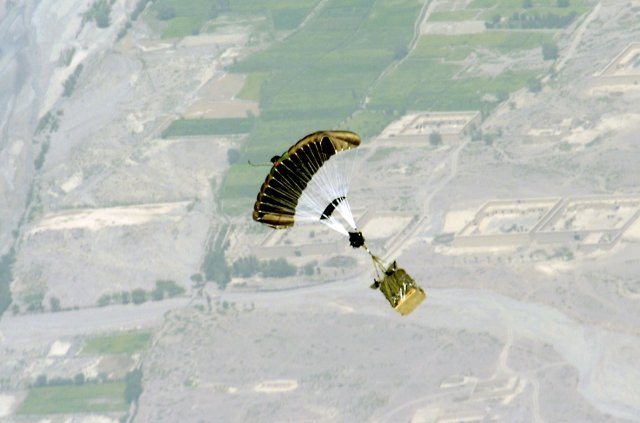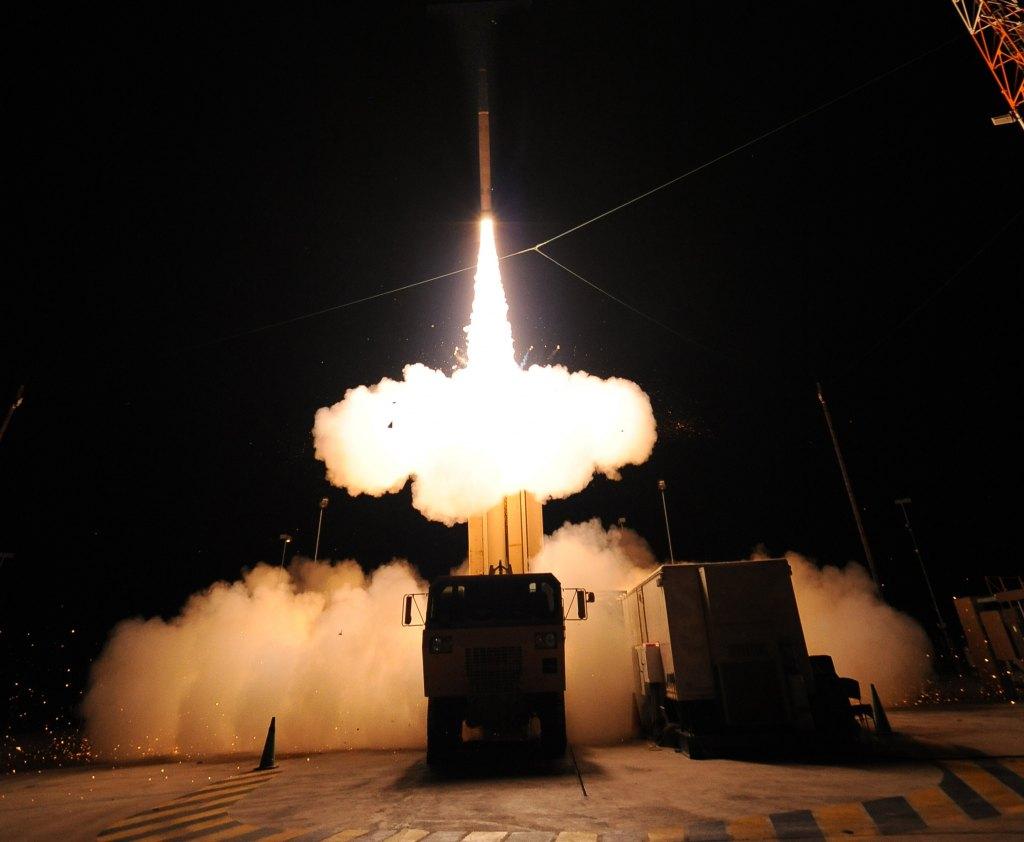A fully equipped Soldier may carry anywhere from 50 to 120 pounds on his or her back in theater. Refinements to precision-guided parachutes may reduce that load — if the Army can just convince Soldiers it can provide supplies to them as needed.
Brig. Gen. Paul A. Ostrowski, with Program Executive Officer, Soldier, known as PEO Soldier, discussed equipping options for Soldiers on Capitol Hill, April 11, before the House Armed Services Committee’s subcommittee on Tactical Air and Land Forces.
In addition to finding newer materials to reduce the weight of protective armor plates for Soldiers, and possibly using things like self-propelled robotics to carry supplies alongside Soldiers on the move, Ostrowski told lawmakers Soldiers might be willing to deploy with fewer supplies if they are convinced the Army can get them what they need on short notice.
“Guaranteed 24/7 aerial resupply; we have the ability to use our current precision-guided parachutes that we have — except the guidance systems are very bulky,” Ostrowski said. “If we can cut the weight of those down or make them disposable, we could allow Soldiers to train with them constantly. And when they believe in their resupply, they will carry less.”
Ostrowski said that while it’s possible for the Army to reduce the load on a Soldiers’ backs by making gear lighter, that doesn’t necessarily mean they will end up carrying less weight.
“We all know that a pound off a Soldier, incrementally, is not a pound off,” he said. “They will simply replace it with something else, because they don’t know if they will get resupplied. If we can guarantee them resupply, and train with it to the point they believe in it, we might absolutely fix this problem long-term.”
Testifying with Ostrowski was Marine Corps Brig. Gen. Eric M. Smith, director, Capabilities Development Directorate, U.S. Marine Corps. Smith told lawmakers that the Marines have the same issue.
“Most of what a Marine is out there carrying is chow, water and ammunition,” he said. “When there is an absolute, guaranteed concept that he is comfortable that he is going to be resupplied — they are going to cut a lot of weight. A gallon of water, once you include the container, is seven pounds — no matter who is carrying it. So once we can take that out of a Marine’s pack, that is going to be a tremendous benefit. Enhancing the logistics piece does go a long way toward lighting the load of the rifleman.”
Lawmakers pointed out that over the last 12 years, funding for improvements in warfighter equipment and protective gear has increased; and that money has largely come from overseas contingency operations budgets meant to fight the war.
The industrial base has also been energized and expanded to ensure Soldier equipment production could be sustained, and that modernization and innovation was a priority. Among advancing technologies are body armor and night vision goggles. Lawmakers were unsure whether the Pentagon’s current fiscal situation given the budget sequester would have an impact on procurement, especially after the drawdown in Afghanistan.
In particular, lawmakers appeared concerned that the incentive to continue advancements in lighter body armor development might disappear if industry was unable to see that the services had committed a certain amount of money to the issue. Currently, funding for procurement and development of protective gear is not explicitly stated in budgets. Instead, it’s included in operations and maintenance accounts. Lawmakers were concerned that if industry is not be able to see how much was specifically was committed by the military to body armor, they would be unable to build business cases to invest their own money in those areas.
Ostrowski told lawmakers that body armor is included in operations and maintenance budgets to ensure flexibility in procurement and development. With that flexibility, he said a new threat in Afghanistan — the dismounted improvised explosive device, or IED — was ameliorated with development of a protective over-garment and undergarment system. The Army was able to provide 66,000 sets of that equipment to Soldiers.
“That flexibility was really highlighted with respect to that procurement,” Ostrowski said.
The general also said the Army, and PEO Soldier, maintain a “very open dialogue” with industry. Despite money for protective gear being “hidden” in an operations and maintenance account, “flexibility is key; with respect to personal protection, our ability to shift is adamantly important across the force.”
BALLISTIC PROTECTION FOR WOMEN
With women seeing combat in Iraq and Afghanistan, and policies having changed about women serving in combat roles, the Army has made great strides in providing protective gear for female Soldiers.
“Female body armor is [the] latest invention we were able to create with industry partners and Natick Labs,” the general said. “And what we were able to accomplish is a weight reduction from 31 pounds in the improved outer tactical vest down to 25 pounds for female body armor.”
He said the Army now has 19 sets of female body armor in theater, in eight sizes. The Army will field 600 sets of the armor in August and September to the next force deploying.
“We will always field female body armor to our deploying forces from this point forward,” Ostrowski said. “From now on, every female Soldier deploying to theater will be given female body armor.”
MISMATCHED CAMMO
In 2005, the Army started fielding the current “Army Combat Uniform,” in the now familiar “Universal Camouflage Pattern.” But at the time, unit-provided equipment such as Kevlar helmets, load bearing equipment and protective vests were not available in the new UCP.
Soldiers in Iraq and Afghanistan who wore the ACU coat and trousers found that their protective vest was in either the poorly-matched green, brown, beige and black “woodland” pattern that was made for the Battle Dress Uniform, or the beige and brown pattern common to the Desert Camouflage Uniform.
One lawmaker said the disparity between the two uniform patterns made Soldiers easy targets for snipers.
Ostrowski said the problem has been resolved.
“Should we decide to undertake a new uniform for the Army, the body armor, the organizational clothing, and the individual equipment will match the family of uniforms very closely,” he said.
The Army is now working on a new set of uniforms, Ostrowski told lawmakers. The new uniform “family” includes three camouflage patterns that share the same geometry but vary in palette. One is for woodland environments, one for desert, and another for the “transitional” environment in between. The expensive organizational equipment, such as protective vests, will be built using the transitional pattern. It has been shown to be operationally effective on all three camouflage options.
“We have gotten to the point of the end of testing with respect to the Phase 4 camouflage program in the Army and what we have learned is that a family of uniforms outperforms a single pattern, a universal camouflage pattern,” Ostrowski said.
Ostrowski also said that the Army had brought in test results from that uniform program. Included were over 120,000 data points from a “uniform test that is unequaled with respect to the DOD. We are bringing those results to the chief of staff of the Army for his guidance going forward.”
THE CARBINE
Lawmakers asked about Army efforts to find a rifle that is more dependable than the M4 Carbine Soldiers currently use. Ostrowski first defended the success of the M4 program, saying that it was introduced as early as 1990, and since then has undergone over 92 adjustments to improve its accuracy and reliability.
“Each one of these changes has brought about a much better weapons system than we ever had before,” Ostrowski said. The initial requirement for the M4, he said, 600 “mean rounds between stoppage,” or MRBS. Recent testing in 2010, he said, shows the M4 — loaded with the common MA55 round — performed at the much more reliable MRBS of 3,692 rounds.
“That’s a six-times increase over the original requirement of 600 rounds between stoppages,” Ostrowski said.
Still, the Army is looking for a better carbine to field to Soldiers, and that effort is called the “Individual Carbine” program.
Ostrowski said the Army has looked “to determine whether or not industry could provide us with a weapons system that was as accurate, as reliable, and was compatible with our current optics, and also had a lifecycle cost that was within a boundary we’ve established now for the M4.”
The competition for a follow-on carbine is ongoing, Ostrowski said, and he said testing of phase 2 proposed weapons was recently completed. The source selection board for the follow-on weapon has been given the relevant testing material to make its decision. It may choose three weapons to move into phase 3 of the competition.
If there is a winner from phase 3, he told lawmakers, the final decision will go before the secretary of the Army for a cost-benefit analysis. It will be compared to the current carbine for accuracy, reliability, lifecycle cost and compatibility with existing accessories.











